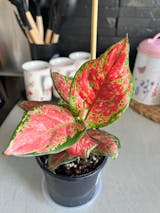Soil and Repotting: Houseplant Care Guide
Beginner's guide to soil and repotting
Your new plant purchase will come already planted in soil (with the exception of tube stock), meaning you can leave it to live there for at least a couple of months. However, you will need to replace the soil (or repot the plant) at some point, and that's where this part of the guide comes in. This post will cover off some of the 101's of soil, when you should repot your plant, how to choose potting mix, what type of pot to use and how to repot a plant.
Throughout this multi-part guide we will provide key take-outs at the beginning of each article so you can choose whether to just read those, or read on through for all the detail. We've also provided a few links for further learning in this one.

Key take-outs
- Repot once every year or so, or when roots are escaping from the pot
- Opt for premium potting mix
- Pots with drainage holes will make plant care much easier
- Avoid going too large with your pot - choose a pot that is just a bit larger than the roots to avoid root rot
- Wait at least a couple of weeks after bringing a new plant home before repotting/changing the soil, it as it needs to acclimate first

Soil aka Potting Mix 101
Whilst the term "soil" is often used for that brown stuff in your pot, in the case of houseplants, the proper term is actually potting mix. Here's a quick breakdown of the difference between the two:
- Soil is the dirt you find outside, a mixture of clay, silt and sand
- Potting mix is a special blend containing such ingredients as peat moss, bark, perlite, nutrients, and a bunch of others. It usually contains little to no actual soil, and has been formulated specifically for certain types of plants in certain living environments
Houseplants live their whole lives in the confines of a pot, and require this special blend in their potting mix to receive the nutrients they require to grow, remain healthy, and fight disease and pests. Plants that live outside, planted in the ground, benefit from decomposing matter, bacteria, worms and other things that affect and change the soil they live in on a daily basis - worms aerate the soil, as well as play a role in decomposing matter and bacteria which in turn creates fresh nutrients for any plants living in it. Plants that live outside are growing in soil that is ever-changing and there's loads of it - they can grow their roots in many directions (across and deep into the ground) to continue seeking new nutrients too. However an indoor plant (or indeed any potted plant) needs human intervention to receive what it needs (water, minerals, nutrients etc.), and have it replaced once consumed.
This is why you're faced with so many choices for soil and potting mix at a hardware store or nursery. There's different mixes to cater for the needs of different plants. For example, an indoor decorative plant needs good drainage and basic nutrients in its potting mix so it can grow taller/longer and produce that lush foliage you lust after. Whereas as a lemon tree growing in a pot, as a comparison, requires its own specific nutrients and pH balance to produce optimal fruit.
When Should You Repot Your Houseplant?
There's a few different reasons to repot a houseplant:
- To refresh the soil - most experts agree that this should happen approximately once a year, as that's about how long it will take for a plant to use all the nutrients in the mix it was in
- When a plant has outgrown its pot. The way to identify this is if roots are escaping either out the top or bottom of the pot. When you see this, it's time for a bigger pot and is a good opportunity to give the plant new potting mix
- If the soil looks like it has lost quality - for example, water runs right off the top (it's become hydrophobic, meaning water is not penetrating the soil, therefore won't reach the roots) or there's a build-up of salt & minerals (which can happen as a result of using tap water over time depending on the quality of your water)
What Potting Mix Should I Use?
To keep it simple, here at Uprooted we recommend using premium potting mix when repotting your plant. These mixes allow for good drainage & have enough nutrients to last a few months. To learn more about choosing the right potting mix, check out this blog article.
Choosing a Pot
This is an individual choice but we recommend opting for a pot with drainage holes such as
- A plastic nursery pot (which are perfectly fine to grow plants in for years) either as is, or housed inside a decorative pot or planter
- A terracotta pot
- A glazed ceramic pot
- Or some other vessel with holes in the base so water can freely drain out
When choosing a pot, bigger isn't always better - some people may believe that giving a plant a big space to grow in will mean loads of room for roots, however in the case of indoor plants, that's not necessarily the case. Because light and heat are limited inside, potting mix can take a long time to dry out in an indoor space, so filling a big pot with loads of soil for a plant with proportionately much smaller roots can lead to potting mix that stays wet for weeks. These scenarios can create root rot. If you haven't checked it out already, visit our section on watering to learn more about the importance of letting soil dry out.
So we recommend choosing a pot that is about one or two sizes larger than the roots of the plant, allowing for roughly a 50/50 ratio of roots to soil.
What Pots Do We Recommend?
We are passionate about making houseplant care easy, so we created our own range of plastic grower pots designed specifically for houseplants. Our Squat Pots range of plastic grower pots are designed to be shorter than a regular plastic plant pot, perfect for houseplants to fit in nicely, reducing the amount of potting mix required, and helping avoid overwatering. These come in clear, silver, jade, teal, and black, in a few sizes, with optional add-ons of clip-on saucers and hangers.
How to repot a plant
Time to get your hands dirty! Repotting is simple, although can be intimidating if it's your first time. Luckily plants are hardy so will forgive you for being thrashed around a little. However we do recommend that you wait a couple of weeks after bringing a new plant home before you repot it, as letting it acclimate first will help avoid how much stress you expose it to at the start.
So, to repot a plant, follow these steps:
- Remove the plant from the pot
- Lay it on its side and gently loosen the roots
- Remove the old potting mix
- Add new soil to your chosen pot - sprinkle some in the base but leave room for the roots of the plant to fit in
- Add the plant and then pack potting mix around and on top of the roots
- Water the plant in
For more details including a step by step guide, check out our repotting guide for indoor plants.
Have any questions?
Get in touch at hello@uprooted.com.au or DM us on Instagram or Facebook. We are just one friendly email or message away!
Want to keep learning?
Head to our next section, which is all about fertiliser and other products that your houseplant may benefit from.








